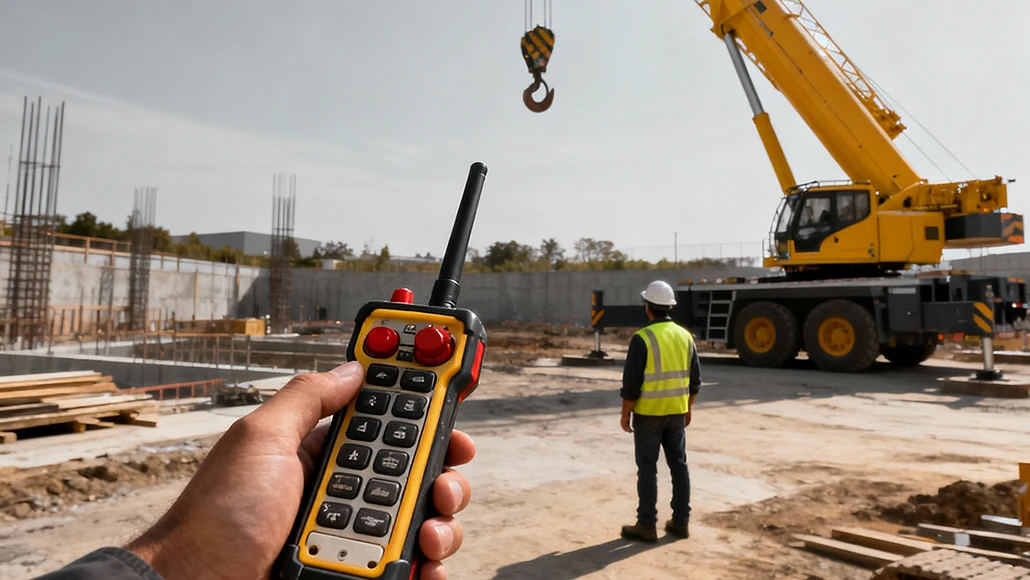Wireless Machine Control for Construction Lifting Equipment
Construction operations have undergone profound transformation as wireless machine control lifting equipment technologies replace traditional wired control systems. This transition addresses fundamental operational challenges while introducing capabilities that enhance safety, efficiency, and operational flexibility. The evolution from pendant controllers and cabin-based operation to wireless systems represents more than technological upgrading; it signifies a comprehensive reimagining of how operators interact with lifting equipment and manage complex construction logistics.
Evolution from Wired to Wireless Control
Traditional lifting equipment control relied on pendant controllers connected directly to cranes through cables, or on operators positioned within crane cabs. These approaches, while functional, imposed significant limitations. Pendant controllers tethered operators to equipment, restricting mobility and forcing personnel to move with loads as cranes traversed construction sites. This physical connection created trip hazards, limited operator vantage points, and exposed workers to risks from falling objects or load instability.
Crane cab operation presented different challenges. Operators elevated high above ground level experienced restricted visibility of ground conditions, personnel positions, and obstacle locations. Communication with ground crews required radio systems or visual signals that proved unreliable in noisy, visually complex construction environments. The isolation of cab-based operation delayed problem recognition and response, sometimes contributing to accidents that might have been prevented with better situational awareness.
Wireless machine control lifting equipment eliminates these constraints by separating operators from physical connection to machinery. Using radio frequency transmission, operators send control commands from handheld or wearable devices to receivers mounted on equipment. This liberation enables operators to position themselves optimally for visibility, maintain safe distances from hazards, and move freely as operational requirements change. The transformation proves particularly valuable in confined spaces, near existing structures, or during complex multi-crane operations where coordination demands comprehensive site awareness.
Technical Architecture of Wireless Control Systems
Modern wireless control systems comprise two primary components working in concert. The transmitter, a handheld or wearable control unit operated by personnel, contains buttons, joysticks, or other input mechanisms that generate command signals. These signals undergo encoding and encryption before transmission as radio frequency signals to the receiver unit mounted on lifting equipment. The receiver decodes incoming signals, verifies authenticity through security protocols, and activates appropriate relays that execute commanded actions.
The sophistication of wireless machine control lifting equipment extends beyond simple command transmission. Advanced systems employ frequency-hopping spread spectrum technology that continuously changes transmission frequencies, minimizing interference from other radio devices and ensuring secure communication resistant to unauthorized access. Real-time bidirectional communication enables feedback from equipment to transmitter, providing operators with load weight information, operational status indicators, and warning alerts about potential problems.
Safety features integrate deeply into wireless control architecture. Emergency stop buttons on transmitters trigger immediate equipment shutdown, overriding other commands and bringing operations to safe halt within milliseconds. Signal interference detection identifies communication problems and activates fail-safe responses that prevent equipment operation when reliable control cannot be assured. Automatic shutdown mechanisms engage when transmitters lose connection with receivers, preventing unintended continued operation if control signals cease.
Ergonomic design considerations shape transmitter development, recognizing that operators may use devices throughout extended shifts. Button layouts reflect human factors research that minimizes accidental activation while ensuring critical controls remain readily accessible. Haptic feedback—vibration alerts—supplements visual indicators, providing tactile confirmation that commands register successfully. Some advanced systems incorporate LCD displays showing real-time equipment status, load weights, and operational parameters, giving operators comprehensive information without shifting attention from lifting operations.
Safety Enhancements Through Wireless Technology
The safety advantages of wireless machine control lifting equipment extend across multiple dimensions. Perhaps most significantly, wireless systems enable operators to maintain optimal positioning relative to loads and work areas. Rather than standing near equipment or elevated in crane cabs, operators position themselves where visibility of the complete operational envelope remains unobstructed. This vantage point allows early identification of potential problems—personnel entering restricted zones, obstacles along movement paths, or load instability indicators—and enables immediate corrective action.
Distance maintenance between operators and active lifting operations reduces injury risks from falling objects, load swing, or equipment malfunction. Wireless control allows operators to remain outside designated fall zones while maintaining complete operational authority. This separation proves especially valuable during particularly hazardous operations such as demolition support, heavy industrial lifts, or work near energized electrical systems.
Enhanced visibility translates directly to accident prevention. Operators unrestricted by physical tethers or cabin positions can move to locations offering clear sight lines to critical areas. When blind spots emerge—a common challenge in construction environments with complex geometries—operators reposition themselves rather than proceeding with compromised awareness. This mobility addresses a fundamental safety challenge that confined operators within cabs or tethered to pendants cannot overcome.
The elimination of pendant cables removes significant trip hazards from construction sites. Cables trailing across floors create obstacles that workers navigating busy areas may not notice, particularly when carrying materials or focused on tasks. Removing these hazards simplifies traffic patterns and reduces fall incidents that generate injuries even when unrelated to lifting operations themselves.
Operational Efficiency and Productivity Gains
Beyond safety improvements, wireless machine control lifting equipment delivers substantial efficiency advantages. Setup time decreases significantly compared to wired systems requiring cable routing and connection. Wireless transmitters activate within seconds, enabling rapid commencement of lifting operations without preparatory delays. This responsiveness proves particularly valuable on projects requiring equipment mobility between multiple locations throughout workdays.
Operational flexibility expands as operators adapt positioning to changing circumstances. Complex lifts involving multiple movement phases benefit from operators repositioning between phases to maintain optimal visibility. When initial positioning proves suboptimal once operations begin, wireless control enables immediate adjustment without interrupting work. This adaptability reduces the conservative positioning margins that wired systems necessitate, allowing more aggressive yet safe operation.
Multi-crane operations gain coordination capabilities from wireless control adoption. Multiple operators, each managing different cranes through wireless systems, can position themselves where comprehensive site awareness remains possible. This positioning facilitates communication and coordination that becomes problematic when operators occupy separated crane cabs or different pendant locations. The resulting coordination improvements reduce delays, prevent conflicts, and enable more efficient sequential or simultaneous lifting operations.
Wireless machine control lifting equipment enables productivity gains through reduced operator transitions and equipment access logistics. Projects requiring operator changes between shifts or work assignments avoid delays associated with cab access or pendant handoffs. New operators activate transmitters and immediately assume control, maintaining operational continuity. Similarly, maintenance personnel can test equipment functionality using wireless controls without climbing into cabs or configuring pendant connections.
Range, Reliability and Environmental Performance
Modern wireless control systems deliver reliable operation across ranges sufficient for typical construction sites. Most systems function effectively at distances exceeding one hundred meters, accommodating the separation distances encountered in building construction, infrastructure projects, and industrial facility work. Some specialized systems extend range considerably further for applications such as port crane operation or large-scale mining equipment control.
Environmental robustness ensures reliable wireless machine control lifting equipment performance despite challenging conditions. Transmitters and receivers feature ruggedized construction resistant to dust ingress, water exposure, impact forces, and temperature extremes. Sealed enclosures with high ingress protection ratings enable operation during inclement weather without compromising functionality or operator safety. This durability proves essential given the harsh conditions that characterize active construction sites.
Battery technology advances support extended operational periods between charging requirements. Modern lithium-ion batteries power transmitters through full work shifts, eliminating the operational interruptions that earlier systems experienced when battery depletion necessitated mid-shift changes. Charge status indicators warn operators when power levels decline, allowing timely battery replacement before exhaustion threatens operational continuity.
Signal reliability receives continuous attention from manufacturers developing wireless machine control lifting equipment. Redundant transmission protocols ensure command delivery even when interference affects individual transmission attempts. Error detection algorithms identify corrupted signals and request retransmission automatically, maintaining operational reliability without operator intervention. The cumulative effect creates systems that operators trust implicitly, a prerequisite for widespread adoption in safety-critical applications.
Integration with Equipment Management Systems
Advanced wireless control systems integrate with broader equipment management platforms, enabling capabilities beyond direct operational control. Data logging functions record operational parameters—lift counts, load weights, cycle times, and duration metrics—providing insights into equipment utilization and performance trends. Fleet managers analyze this information to optimize equipment deployment, identify underutilized assets, and justify acquisition decisions based on empirical usage patterns.
Maintenance management benefits from wireless system integration with equipment monitoring capabilities. Operational data reveals patterns that indicate developing maintenance needs before failures occur. Unusual cycle times, load handling irregularities, or performance degradation trigger maintenance alerts that enable proactive intervention. This predictive approach minimizes unplanned downtime while extending equipment lifespan through timely preventive maintenance.
Some wireless systems incorporate operator identification features that link specific personnel to equipment usage. This accountability encourages proper operation while providing objective performance data useful for training assessment and certification validation. When incidents occur, usage logs establish factual operational timelines that support thorough investigation and appropriate response.
Implementation Considerations and Best Practices
Successful wireless machine control lifting equipment adoption requires systematic approaches addressing technical, operational, and human factors. Equipment selection should align with specific operational requirements, site conditions, and organizational capabilities. Overly complex systems introduce unnecessary complications, while inadequate capabilities force workarounds that undermine efficiency and safety objectives.
Operator training assumes critical importance during wireless system implementation. Despite intuitive interfaces, comprehensive training ensures operators understand system capabilities, limitations, and emergency procedures. Training programs should address proper transmitter handling, button function purposes, safety feature operation, battery management, and troubleshooting basic problems. Hands-on practice under supervision builds operator confidence and competence before independent operation begins.
Maintenance protocols specific to wireless systems warrant establishment. Regular inspections verify transmitter and receiver physical condition, battery performance, and antenna integrity. Functional testing confirms reliable communication across expected operational ranges. Firmware updates maintain security and functionality as manufacturers release improvements addressing identified issues or adding capabilities.
Regulatory Compliance and Standards
Wireless machine control lifting equipment must comply with various regulatory frameworks governing radio frequency device operation, industrial equipment safety, and construction site management. Most jurisdictions regulate radio frequency spectrum usage, requiring wireless control systems to operate within designated frequency bands and meet electromagnetic compatibility standards. Manufacturers typically obtain necessary approvals before marketing equipment, but users should verify compliance within their specific operating regions.
Safety standards increasingly recognize wireless control as acceptable practice for lifting equipment operation. Industry associations and standards organizations have developed guidelines addressing wireless system reliability, safety feature requirements, and operator training. Compliance with these standards demonstrates due diligence and may influence liability determinations following incidents.
Future Technological Directions
The evolution of wireless machine control lifting equipment continues as supporting technologies advance. Fifth-generation cellular networks promise enhanced communication reliability, lower latency, and improved interference resistance. These characteristics may enable more sophisticated control approaches including high-definition video transmission from equipment-mounted cameras directly to operator displays.
Augmented reality integration represents another development frontier. Operators might wear smart glasses displaying real-time load weight information, equipment status indicators, and collision warnings overlaid on their direct visual field. This information integration could further enhance situational awareness while maintaining operator focus on physical operations.
The convergence of wireless control with autonomous operation creates possibilities for graduated automation where operators provide high-level direction while systems handle detailed execution. Such approaches might enable single operators to supervise multiple pieces of equipment simultaneously, fundamentally changing productivity calculations and workforce deployment strategies.
As wireless machine control lifting equipment technologies mature and costs decrease, adoption will extend across equipment categories and project scales, establishing wireless operation as standard practice rather than premium feature, fundamentally reshaping how the construction industry approaches lifting equipment control and operator safety.































